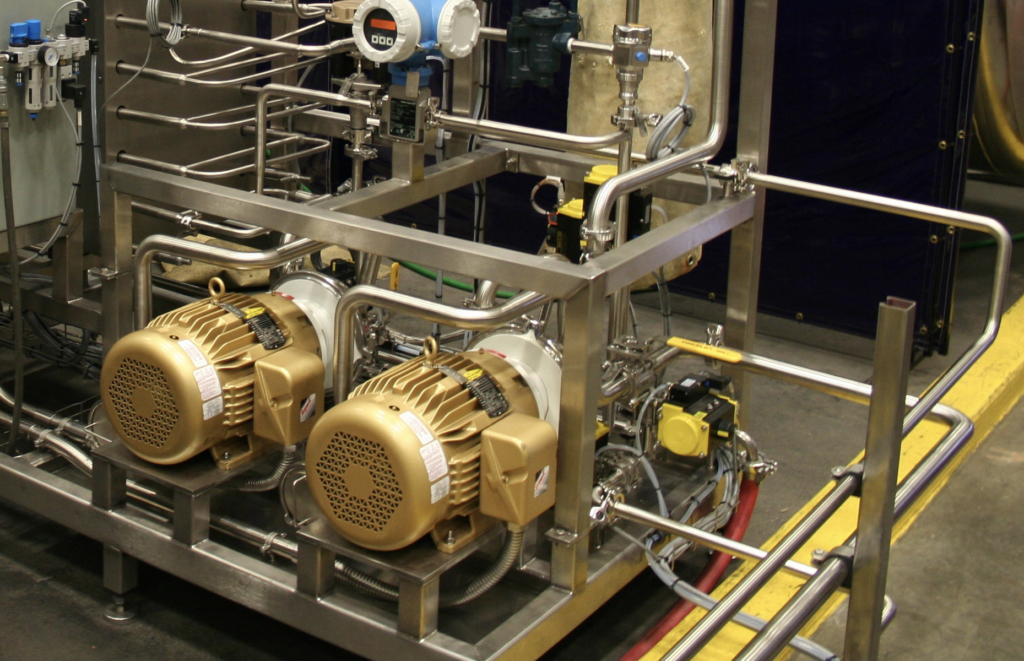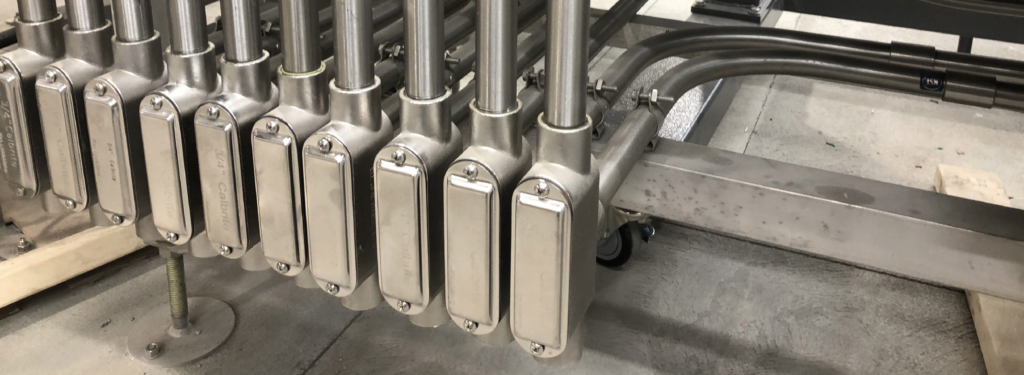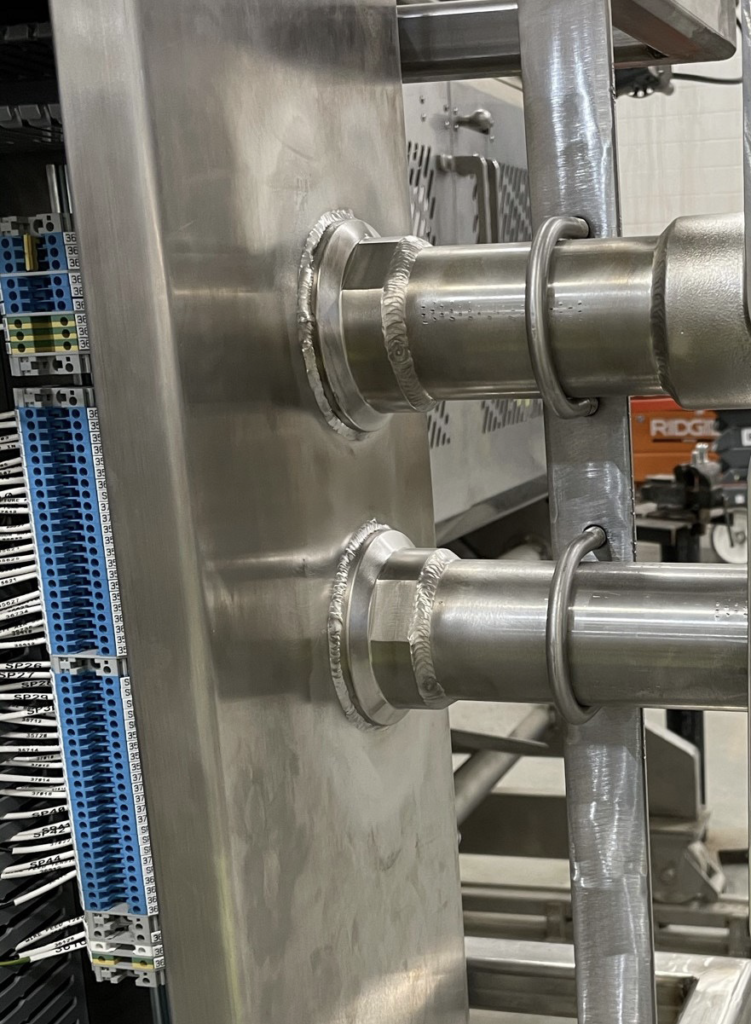Welding of Conduit and Tubing Systems
STAINLESS STEEL CONDUIT COMMITTEE, 2024
The use of welding as an installation technique for electrical conduit systems in the food and beverage industry is a common practice, despite the safety and performance concerns that result from it.This paper seeks to inform the reader of the problems and dangers that can arise from a welded conduit system.

I. THE LEGAL REQUIREMENTS

The use of welded raceway systems is a violation of both the National Electrical Code® (NEC®) and federal requirements of the Occupational Safety and Health Administration (OSHA).
The NEC is the standard for electrical installations in the United States and several countries throughout North, Central, and South America. It is legally adopted in all 50 states, and it specifically prohibits the use of welding as part of a conduit or tubing installation. Section 300.18(B) states that “metal raceways shall not be supported, terminated or connected by welding to the raceway unless specifically designed to be or otherwise specifically permitted to be in this Code.” The term “raceway” is used in the NEC as a blanket term covering conduit, tubing, and other systems designed for holding electrical conductors, although this paper will use the words raceway, conduit, and tubing interchangeably.
OSHA requires all electrical products to be certified by a nationally recognized testing laboratory. OSHA standard 1910 Subpart S covers electrical installations in the workplace. Section 1910.303(a) indicates that “the conductors and equipment required or permitted by this subpart shall be acceptable only if approved, as defined in 1910.399.” The term approved is defined in 1910.399 as “…accepted, or certified, or listed, or labeled, or otherwise determined to be safe by a nationally recognized testing laboratory…”. A welded raceway system is not compliant with this section and therefore not only violates the NEC, but also federal safety regulations.
II. WHY SOME THINK IT “DOESN’T MATTER” OR THAT A WELDED CONDUIT SYSTEM IS A “BETTER SYSTEM”
There seem to be two reasons for welding electrical raceways. The first is a belief that welding, instead of using the typical methods of couplings and connectors at conduit terminations, is not a safety or even performance issue and therefore “doesn’t matter.” The second is a belief that welding results in a better installation because it results in a completely “sealed” system that can be easily cleaned and is waterproof.

III. WHY IT DOES MATTER AND WHY IT IS NOT A “BETTER SYSTEM”
NEC-compliant rigid conduit installation
Welding any conduit system is a poor design choice, and welding stainless steel systems is especially problematic. Unlike piping systems for moving gases or liquids, an empty conduit does not become full by simply opening a valve. Conductors must be physically pulled through the conduit system, which can result in damaging the wire’s insulation when sharp protrusions exist. The potential for damage is greatly reduced by following the requirements of the NEC, including the limitations on the number of bends and how they are made, as well as using proper fittings and deburring the conduit at cut ends. The inside of a welded raceway often includes surface irregularities that are not visible after the welding is performed. These irregularities are typically rough and can easily damage conductor insulation, particularly during the initial installation. If the conductor insulation is damaged the wire can fault, or short-circuit, to the raceway, resulting in the conduit system becoming energized at voltages that are potentially lethal. This is even more likely to occur in areas with frequent washdown of the system because welding stainless steel often results in weld granulation, also known as “sugaring.” Weld granulation can leave small openings in the weld which will allow water into the conduit. This water intrusion further exacerbates the problem of insulation damage and is a recipe for disaster.
Electrical conduit is required to undergo strict testing to ensure compliance with the applicable UL product standards (UL 6/6A for rigid metal conduit, UL 1242 for intermediate metal conduit, and UL 797/797A for electrical metallic tubing). Conduit fittings must also be tested to ensure compliance with UL 514B. Compliance with these standards ensures that, among other things, a complete raceway system will have a low enough electrical impedance that it will open the circuit overcurrent protective device in the event of a ground fault. Put simply, the conduit must be capable of causing the circuit breaker to trip or the fuse to open if the conduit becomes energized. Using conduit and fittings that are listed by a qualified testing laboratory, such as UL or Intertek, and are properly installed according to manufacturers’ instructions helps ensure a safe installation. A welded raceway system will not have the same electrical characteristics as a system that employs proper fittings. Due to this, it is not known if a welded raceway that becomes energized will open the circuit breaker or fuse, or if it will simply remain energized and injure or kill anyone that contacts it.
The opinion that a welded stainless raceway is a “better system” than one that uses proper fittings is also unfounded. The safety concerns already discussed show that it cannot possibly be a “better system,” and the performance of the system also shows that fittings are superior to welding. Conduit fittings used in wet locations require a minimum listing of “raintight.” Raintight fittings pass the water intrusion tests of UL 514B. Any weld made in the field is likely to be less than perfect, and a completed system that contains only perfectly welded 4 seams is simply not realistic. Weld granulations will allow pinholes to form and water to intrude. Welding of any non-low carbon alloy (e.g., 304, 316, CF8, CF8M) also results in sensitization, or carbide precipitation, which creates a localized corrosion risk that can only be corrected through annealing. Heat tints or discoloration are indicative of damage to the protective layer of stainless steel. This damage results in the degradation of the stainless steel’s inherent resistance to corrosion. Cross-contamination of stainless steel and carbon steel is also a common occurrence during field welding and promotes raceway corrosion.

IV. CONCLUSION
An effective electrical installation must meet facility performance requirements while adhering to National Electrical Code and Occupational Safety and Health Administration safety standards. Welded conduit systems fail to fulfill these criteria, exposing installations to increased corrosion risk, equipment damage, and potential life-threatening situations. Traditional conduit installations, designed in accordance with industry standards not only ensure safety and compliance but also safeguard against equipment deterioration and risks to personnel. The importance of adhering to proven methods cannot be understated when the well-being of individuals and the reliability of electrical systems are at stake.